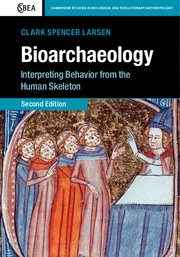Book contents
- Frontmatter
- Dedication
- Contents
- Preface to the Second Edition
- Preface to the First Edition
- 1 Introduction
- 2 Stress and deprivation during growth and development and adulthood
- 3 Exposure to infectious pathogens
- 4 Injury and violence
- 5 Activity patterns: 1. Articular degenerative conditions and musculoskeletal modifications
- 6 Activity patterns: 2. Structural adaptation
- 7 Masticatory and nonmasticatory functions: craniofacial adaptation to mechanical loading
- 8 Isotopic and elemental signatures of diet, nutrition, and life history
- 9 Biological distance and historical dimensions of skeletal variation
- 10 Bioarchaeological paleodemography: interpreting age-at-death structures
- 11 Bioarchaeology: skeletons in context
- References
- Index
- Plate section
7 - Masticatory and nonmasticatory functions: craniofacial adaptation to mechanical loading
Published online by Cambridge University Press: 05 April 2015
- Frontmatter
- Dedication
- Contents
- Preface to the Second Edition
- Preface to the First Edition
- 1 Introduction
- 2 Stress and deprivation during growth and development and adulthood
- 3 Exposure to infectious pathogens
- 4 Injury and violence
- 5 Activity patterns: 1. Articular degenerative conditions and musculoskeletal modifications
- 6 Activity patterns: 2. Structural adaptation
- 7 Masticatory and nonmasticatory functions: craniofacial adaptation to mechanical loading
- 8 Isotopic and elemental signatures of diet, nutrition, and life history
- 9 Biological distance and historical dimensions of skeletal variation
- 10 Bioarchaeological paleodemography: interpreting age-at-death structures
- 11 Bioarchaeology: skeletons in context
- References
- Index
- Plate section
Summary
Introduction
The influence of environment and behavior on skull morphology was first discussed centuries ago. In the fifth century BC, Herodotus remarked on apparent differences in cranial robusticity between Persians and Egyptians: “The skulls of Persians are so weak that if you so much as throw a pebble at one of them, you will pierce it; but the Egyptian skulls are so strong that a blow with a large stone will hardly break them.” He interpreted the strength of Egyptian skulls to the lifelong exposure of their heads to the sun. Since the time of Herodotus, the influence of environment and behavior, no matter how specious the interpretation, has been only minimally considered in discussions of cranial morphology in archaeological remains. Beginning in the eighteenth century, osteologists relied on craniofacial variation for determining population history and classification, with little attention given to the biological significance of observed patterns, especially from a population perspective (Armelagos et al., 1982; Carlson & Van Gerven, 1979; Cook, 2006; Larsen & Walker, 2010; Powell, 2005). As with the study of long bone morphology discussed in Chapter 6, there has been a gradual reorientation from typological/historical to population variation analyses. This emphasis focuses on processes and functions that influence cranial morphology, revealing the adaptive and behavioral significance of variation from a population perspective.
This chapter’s central discussion is built on the premise that craniofacial morphology is a biological ensemble, influenced by processes involving the central role of the masticatory complex – composed of the jaws, teeth, and associated muscle – bone interactions – during growth and development and throughout adulthood (Daegling, 2010; Lieberman, 2011). Both intrinsic and extrinsic factors influence craniofacial growth, just as with any other skeletal tissue in the body. Throughout life, the cranium grows and adapts in an epigenetic context where environmental and functional factors operate on an underlying genetic infrastructure (Carlson, 2005).
- Type
- Chapter
- Information
- BioarchaeologyInterpreting Behavior from the Human Skeleton, pp. 256 - 300Publisher: Cambridge University PressPrint publication year: 2015

